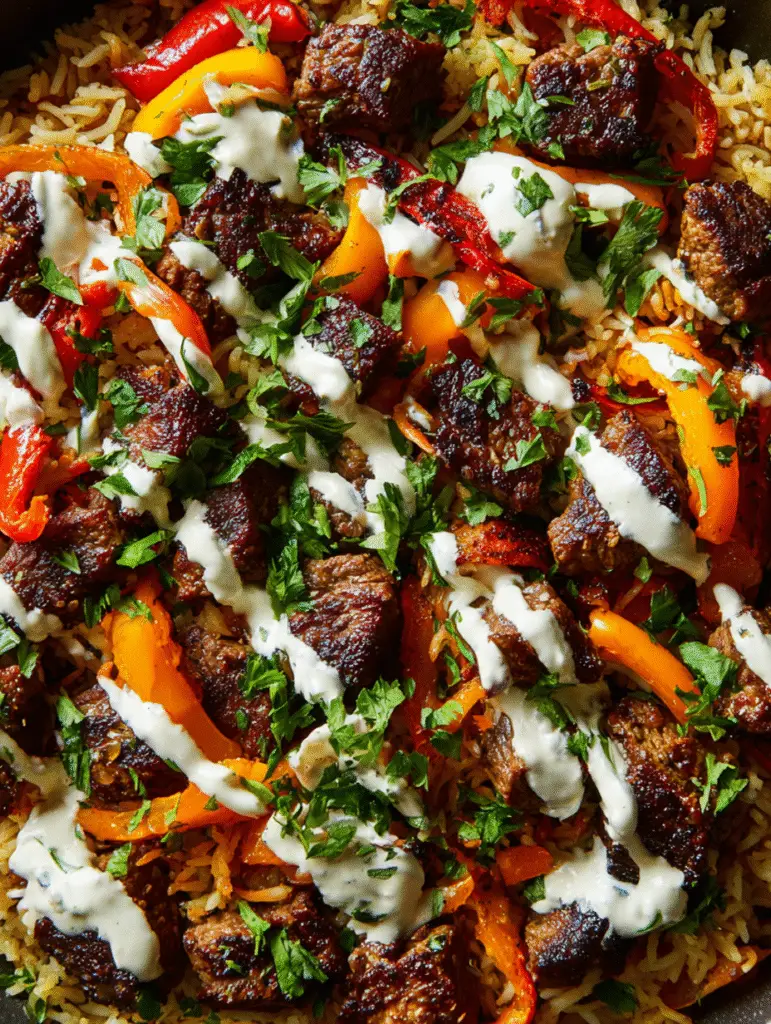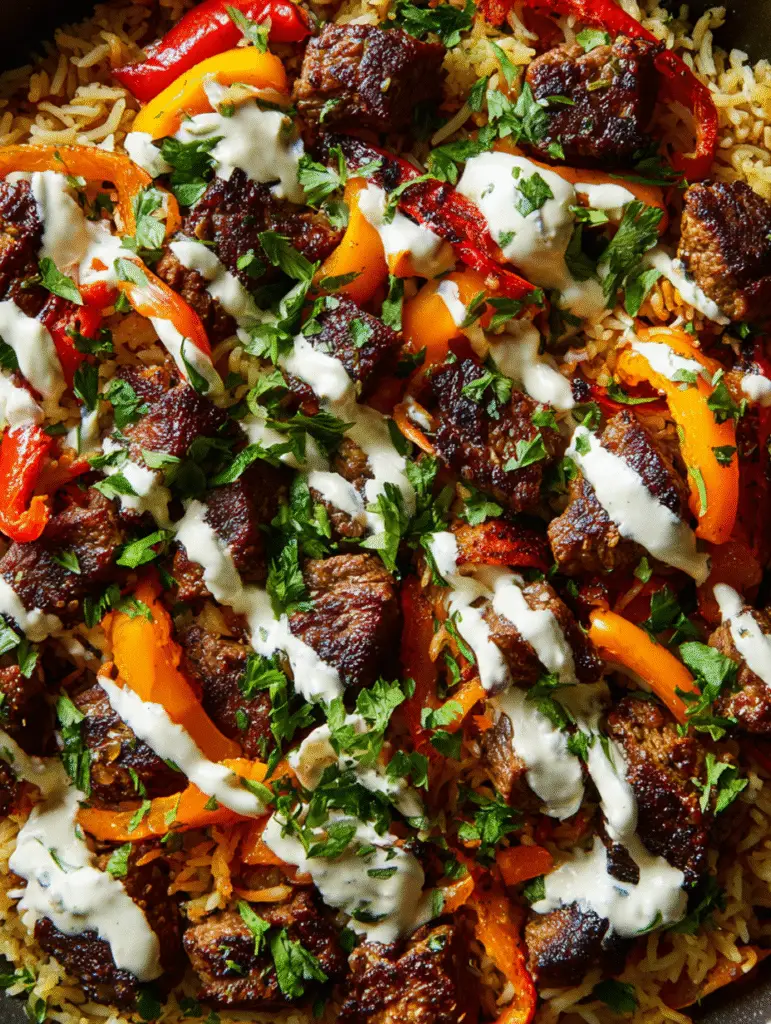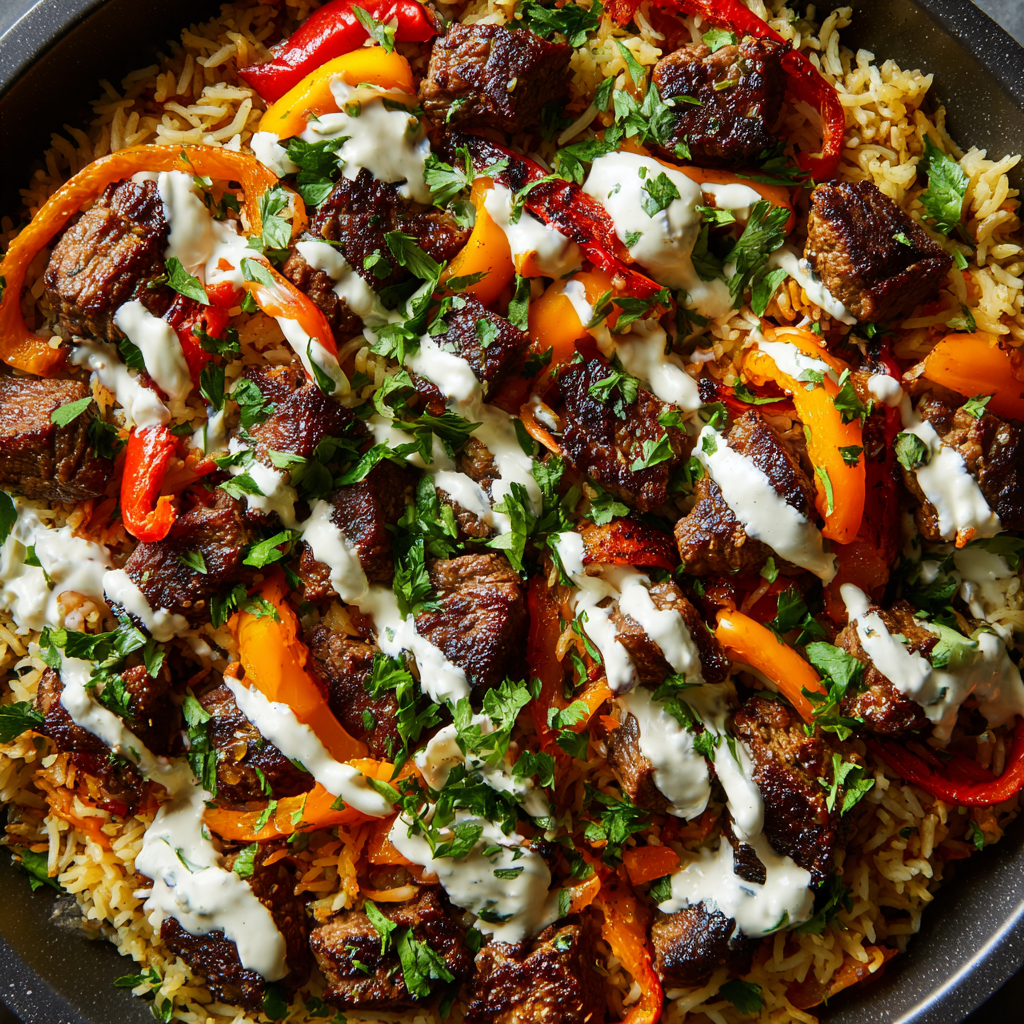Prep Time: 15 minutes
Cook Time: 20 minutes
Total Time: 35 minutes
Category: Dinner
Cuisine: American
Servings: 4
Last winter, after a particularly long day at work, I stood in front of my open refrigerator feeling completely uninspired. I had steak, rice, and cheese—ingredients that individually seemed boring, but together sparked an idea. What if I combined them into one incredible bowl? That experimental dinner became this recipe, which my family now requests at least twice a month. My teenage son declared it “better than any restaurant,” while my husband appreciates that it looks fancy but comes together in less than forty minutes.
The genius of this dish lies in how three simple components—seasoned steak, flavorful rice, and creamy queso—create something far greater than the sum of their parts. Each element is delicious on its own, but when combined in one bowl, the textures and flavors interplay in the most satisfying way. The tender steak provides protein and richness, the aromatic rice adds substance and warmth, while the silky queso ties everything together with its indulgent, cheesy goodness.
Why This Rice Bowl Will Become Your New Favorite
Restaurant-quality results at home make this recipe perfect for impressing dinner guests or treating your family to something special. The presentation looks like something you’d order at an upscale tex-mex restaurant, complete with that gorgeous cheese drizzle cascading over perfectly seared steak. Yet the techniques are straightforward enough for weeknight cooking, requiring no special skills or equipment.
Customizable heat levels mean everyone at the table can enjoy this dish regardless of spice tolerance. The base recipe offers mild, crowd-pleasing flavor, while the optional cayenne in the queso and jalapeño toppings let heat-seekers amp up the intensity. This flexibility makes it ideal for families with varying taste preferences.
One-bowl meal simplicity eliminates the need for multiple side dishes and complicated menu planning. You’re getting protein, grains, dairy, and vegetables all in one satisfying bowl. The complete nutrition profile means you can serve this as-is without feeling like something’s missing from the meal.
Beef broth-infused rice elevates this from ordinary to extraordinary by adding depth you won’t find in plain steamed rice. This simple swap transforms the rice into a flavorful component rather than just a bland base. The aromatic garlic and smoky paprika further enhance the savory profile that complements the steak beautifully.
Make-ahead components allow you to prep different elements at various times, making dinner assembly lightning-fast. Cook the rice earlier in the day, prep your steak seasoning, or even make the queso sauce ahead and reheat it gently. This flexibility accommodates busy schedules without sacrificing homemade quality.
Ingredients You’ll Need
For the Perfectly Seasoned Steak
- 1 lb steak strips – Sirloin, flank, or ribeye work best; cut against the grain for tenderness
- 1 tablespoon olive oil – For searing and preventing sticking
- 1 teaspoon salt – Essential for bringing out the beef’s natural flavor
- ½ teaspoon black pepper – Adds subtle heat and depth
- 1 teaspoon garlic powder – Creates savory umami notes
- ½ teaspoon paprika – Provides color and mild sweetness
- ½ teaspoon cumin – Brings earthy, slightly smoky undertones
For the Flavorful Rice Base
- 1 cup jasmine or basmati rice – Long-grain varieties maintain the best texture
- 2 cups beef broth – The secret to deeply flavorful rice
- 1 tablespoon butter – Adds richness and prevents clumping
- ½ teaspoon salt – Seasons the rice throughout
- ½ teaspoon garlic powder – Echoes the garlic in the steak
- ¼ teaspoon smoked paprika – Provides subtle smokiness
For the Creamy Queso Sauce
- 1 cup shredded white cheddar cheese – Sharp white cheddar provides the best flavor
- ½ cup Monterey Jack cheese – Adds creaminess and melts smoothly
- ¾ cup heavy cream – Creates the silky sauce base
- 2 tablespoons cream cheese – Helps prevent graininess and adds body
- ½ teaspoon garlic powder – Unifies the flavor profile
- ¼ teaspoon cayenne pepper – Optional heat that can be adjusted to taste
Optional Toppings for Extra Flavor
- 2 tablespoons fresh cilantro, chopped – Adds fresh, herbaceous brightness
- 1 jalapeño, sliced – Provides heat and crunch
- 1 tablespoon sour cream – Cooling element that balances richness
- ½ cup diced tomatoes – Fresh acidity and color contrast
Step-by-Step Instructions
Prepare the Aromatic Rice
Begin by combining beef broth, butter, salt, garlic powder, and smoked paprika in a medium saucepan over high heat. Bring this mixture to a rolling boil, stirring occasionally to ensure the butter melts completely and the seasonings distribute evenly. Once boiling, add your rice and give it a quick stir to prevent any grains from sticking to the bottom.
Reduce the heat to the lowest setting, cover the pot with a tight-fitting lid, and set a timer for 15-18 minutes. Resist the temptation to lift the lid and check on the rice—this releases steam and interferes with proper cooking. You’ll know it’s done when all the liquid has been absorbed and the rice appears fluffy. Remove from heat, fluff gently with a fork to separate the grains, and set aside while you prepare the steak.
Season and Sear the Steak
While your rice cooks, prepare your steak by patting it completely dry with paper towels. Moisture on the surface prevents proper browning, so this step is crucial. In a small bowl, combine salt, black pepper, garlic powder, paprika, and cumin. Sprinkle this seasoning mixture evenly over all sides of the steak strips, pressing gently to help it adhere.
Heat olive oil in a large skillet over medium-high heat until it shimmers but doesn’t smoke. Carefully add the seasoned steak strips to the hot pan, making sure not to overcrowd—work in batches if necessary. Let the steak cook undisturbed for 3-4 minutes to develop a beautiful brown crust. Flip each piece and cook the other side for another 3-4 minutes for medium doneness, or adjust timing based on your preference and the thickness of your strips.
Rest the Meat for Maximum Juiciness
Once your steak reaches the desired doneness, transfer it immediately to a clean cutting board or plate. This resting period is non-negotiable if you want juicy, tender steak. During cooking, the meat’s juices are pushed toward the center by heat. Resting for 5 minutes allows those juices to redistribute throughout the meat, ensuring every bite is moist and flavorful rather than dry. Tent the steak loosely with foil to keep it warm during this time.
Create the Silky Queso Sauce
In a small saucepan, pour the heavy cream and set it over low heat. Low temperature is essential here—high heat will cause the dairy to separate and become grainy. Once the cream is warm but not boiling, add the cream cheese in small pieces. Stir constantly with a whisk or wooden spoon until it melts completely into the cream, creating a smooth base.
Gradually add the shredded white cheddar and Monterey Jack cheeses, adding just a handful at a time. Wait until each addition is almost completely melted before adding more. This patient approach prevents the cheese from clumping and ensures a silky-smooth sauce. Once all the cheese has melted, stir in the garlic powder and cayenne pepper if using. Keep the sauce on the lowest heat setting, stirring occasionally to prevent a skin from forming on top.
Assemble Your Beautiful Rice Bowls
Divide the flavorful rice evenly among four serving bowls, creating a bed that covers the bottom and rises slightly up the sides. This creates a natural well in the center for the steak and sauce. Slice the rested steak against the grain into bite-sized pieces if you haven’t already, then arrange these pieces attractively over the rice in each bowl.
Using a ladle or large spoon, drizzle the warm queso sauce generously over the steak, allowing it to cascade down the sides and pool around the rice. Don’t be shy with the cheese—this is what makes the dish truly indulgent and brings all the components together.
Add Final Touches and Serve
Top each bowl with your choice of optional garnishes. I love the contrast of fresh cilantro against the rich cheese, while diced tomatoes add brightness and jalapeños provide extra heat for those who want it. A small dollop of sour cream in the center not only looks elegant but also provides a cooling element that balances the richness. Serve immediately while the queso is still warm and flowing—this dish is best enjoyed fresh.

Serving Suggestions for Complete Meals
Serve this hearty rice bowl alongside a simple side salad dressed with lime vinaigrette to cut through the richness. Mixed greens, sliced radishes, and avocado create a refreshing contrast that cleanses the palate between bites. The acidity from the dressing helps balance the creamy queso sauce.
Warm tortillas or tortilla chips make excellent accompaniments, allowing diners to scoop up every last bit of cheesy rice. Some guests enjoy building mini tacos with the steak and rice, turning the bowl into an interactive dining experience. This versatility makes it fun for casual gatherings.
For a complete tex-mex spread, pair these bowls with Mexican street corn, black beans, or a fresh pico de gallo. The combination creates a restaurant-style feast that impresses guests while remaining manageable for the home cook. Each side brings different textures and flavors that complement the main dish.
Ice-cold Mexican beer or a classic margarita pairs beautifully with the bold, savory flavors. The carbonation and citrus notes refresh the palate between bites of rich, cheesy rice. For non-alcoholic options, try fresh lime agua fresca or hibiscus tea.
Consider making this the centerpiece of a build-your-own rice bowl bar for parties. Set out the components separately along with various toppings, letting guests customize their bowls. This approach works wonderfully for feeding crowds with different preferences and dietary needs.
Creative Variations to Explore
Chicken Queso Rice
Substitute the steak with seasoned chicken breast or thighs cut into strips. Use chicken broth instead of beef broth in the rice for cohesive flavor. This lighter version still delivers incredible taste while being slightly less indulgent and often more budget-friendly.
Spicy Chipotle Version
Add a tablespoon of adobo sauce from canned chipotles to your queso for smoky heat. Season the steak with chipotle powder instead of regular paprika. Top with pickled jalapeños and a squeeze of lime for maximum flavor impact that spice lovers will adore.
Loaded Fajita Bowl
Add sautéed bell peppers and onions to the steak during the last few minutes of cooking. Season everything with fajita seasoning instead of the individual spices listed. This creates a complete fajita experience in rice bowl form.
Breakfast Steak Bowl
Transform this into a hearty breakfast by topping each bowl with a fried or poached egg. The runny yolk mixes with the queso to create an even richer sauce. Add some black beans and hot sauce for a southwestern breakfast that fuels your entire morning.
Vegetarian Queso Rice
Replace the steak with seasoned black beans, roasted sweet potatoes, or grilled portobello mushrooms. Use vegetable broth instead of beef broth in the rice. The queso sauce remains the star, proving this concept works beautifully without meat.
Make-Ahead Tips for Busy Schedules
The rice can be cooked up to 3 days in advance and stored in an airtight container in the refrigerator. When ready to use, reheat it in the microwave with a tablespoon of water or broth, covered, for 2-3 minutes. Fluff with a fork before serving to restore the fluffy texture.
Season your steak strips and store them in a sealed container or zip-top bag in the refrigerator for up to 24 hours before cooking. This marinating time actually enhances flavor penetration, making the steak even more delicious. Just bring it to room temperature for 15 minutes before cooking for even heat distribution.
The queso sauce can be made up to 2 days ahead and refrigerated in an airtight container. Reheat it gently in a saucepan over low heat, whisking in a splash of cream or milk to restore the smooth consistency. Never reheat queso in the microwave without stirring every 30 seconds, as it can separate.
Prep all your toppings in advance by washing and chopping cilantro, slicing jalapeños, and dicing tomatoes. Store each separately in small containers in the refrigerator for up to 2 days. This makes final assembly incredibly quick when you’re ready to eat.
For ultimate convenience, cook everything completely and store components separately. When ready to serve, reheat the rice and steak together in a skillet with a splash of broth, warm the queso separately, then assemble. While not quite as perfect as fresh, this method works well for meal prep situations.
Important Notes for Perfect Results
Using high-quality steak makes a tremendous difference in the final dish. Ribeye offers the most marbling and flavor, while sirloin provides a leaner option that’s still tender. Flank steak works beautifully but must be sliced very thinly against the grain to avoid toughness. Avoid using lean cuts like round steak, which become chewy regardless of cooking method.
Letting the steak rest is non-negotiable for juicy results. Cutting into steak immediately after cooking causes all those precious juices to run out onto the cutting board instead of staying in the meat. Just five minutes of patience rewards you with significantly better texture and flavor in every bite.
Keeping queso on low heat prevents graininess that occurs when cheese proteins seize up from excessive heat. If your sauce does become grainy, try whisking in a teaspoon of cornstarch mixed with a tablespoon of cold water. This sometimes helps bring it back together, though prevention through low heat is always better.
Fresh-shredded cheese melts more smoothly than pre-shredded varieties, which contain anti-caking agents that interfere with melting. If you must use pre-shredded cheese, expect a slightly less silky sauce. For best results, buy a block and shred it yourself—it only takes a few minutes.
Beef broth transforms ordinary rice into something special that can stand on its own as a side dish. Don’t skip this upgrade and use water, as you’ll lose significant flavor depth. Low-sodium broth gives you better control over the final salt level.

Frequently Asked Questions
Can I use ground beef instead of steak strips?
Absolutely! Brown one pound of ground beef with the same seasonings for a more budget-friendly version. Drain excess fat before adding to the rice bowls. The texture will be different but equally delicious, and this adaptation makes the recipe more accessible for tight budgets.
What if I don’t have both types of cheese for the queso?
You can use all cheddar or all Monterey Jack if that’s what you have available. The sauce will still be creamy and delicious, though the flavor and melting properties will be slightly different. Some cooks successfully use Colby Jack, pepper jack, or even mozzarella in a pinch.
How do I prevent my rice from becoming mushy?
Use the correct rice-to-liquid ratio (1 cup rice to 2 cups liquid) and don’t lift the lid while cooking. Once the liquid is absorbed, remove from heat immediately and let it sit covered for 5 minutes. Fluffing with a fork rather than stirring also helps maintain distinct grains.
Can this recipe be made in an Instant Pot?
Yes! Cook the rice using the rice setting with beef broth. While rice cooks, prepare the steak in a separate pan. The queso should still be made on the stovetop for best texture control. The Instant Pot streamlines the rice portion but doesn’t save much overall time.
What’s the best way to reheat leftovers?
Store components separately if possible. Reheat rice and steak together in a skillet with a splash of broth, or microwave covered for 2-3 minutes. Warm the queso separately on the stovetop, adding a bit of cream to restore consistency. Assemble just before eating for best texture.
Is there a way to make this lower in calories?
Use lean sirloin, substitute cauliflower rice for regular rice, and make the queso with reduced-fat cheeses and half-and-half instead of heavy cream. You’ll sacrifice some richness, but the dish remains satisfying. Smaller portions with extra vegetables as toppings also help reduce calories.
Can I make this ahead for meal prep?
Yes, this works well for meal prep when stored properly. Keep components separate in airtight containers—rice in one, steak in another, and queso in a third. Reheat and assemble fresh for each meal throughout the week. The flavors actually deepen over a day or two.
What cut of steak is most budget-friendly for this recipe?
Flank steak offers the best balance of flavor and affordability. When sliced very thinly against the grain, it’s tender and delicious. Sirloin tip or top round can work but require even more careful slicing. Shop sales and stock up when you find good prices on ribeye or strip steak.
Nutrition Information (per serving):
Calories: 380 | Fat: 22g | Carbohydrates: 42g | Fiber: 2g | Protein: 35g
Pro Tips for Success:
- Slice steak against the grain for maximum tenderness
- Use a meat thermometer to achieve perfect doneness (135°F for medium)
- Make extra queso sauce—everyone always wants more!
- Let all components come together while still warm for the best flavor integration

